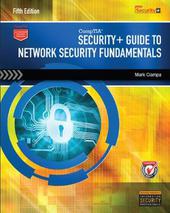
|
CompTIA Security+ Guide to Network Security Fundamentals (with CertBlaster Printed Access Card)
Mixed media product
Main Details
| Title |
CompTIA Security+ Guide to Network Security Fundamentals (with CertBlaster Printed Access Card)
|
| Authors and Contributors |
By (author) Mark Ciampa
|
| Physical Properties |
| Format:Mixed media product | | Pages:608 | | Dimensions(mm): Height 231,Width 187 |
|
| Category/Genre | Creative writing and creative writing guides
Computer security
Network security |
|---|
| ISBN/Barcode |
9781305093911
|
| Classifications | Dewey:005.8 |
|---|
| Audience | | Tertiary Education (US: College) | |
|---|
| Edition |
5th edition
|
|
Publishing Details |
| Publisher |
Cengage Learning, Inc
|
| Imprint |
Course Technology Inc
|
| Publication Date |
5 August 2014 |
| Publication Country |
United States
|
Description
This best-selling guide provides a complete, practical, up-to-date introduction to network and computer security. SECURITY+ GUIDE TO NETWORK SECURITY FUNDAMENTALS, Fifth Edition, maps to the new CompTIA Security+ SY0-401 Certification Exam, providing thorough coverage of all domain objectives to help readers prepare for professional certification and career success. The text covers the essentials of network security, including compliance and operational security; threats and vulnerabilities; application, data, and host security; access control and identity management; and cryptography. The extensively updated Fifth Edition features a new structure based on major domains, a new chapter dedicated to mobile device security, expanded coverage of attacks and defenses, and new and updated information reflecting recent developments and emerging trends in information security, such as virtualization. New hands-on and case activities help readers review and apply what they have learned, and end-of-chapter exercises direct readers to the Information Security Community Site for additional activities and a wealth of learning resources, including blogs, videos, and current news and information relevant to the information security field.
Author Biography
Dr. Mark Ciampa is a professor of information systems in the Gordon Ford College of Business at Western Kentucky University in Bowling Green, Kentucky. Prior to this current role, he served as an associate professor and the director of academic computing at Volunteer State Community College in Gallatin, Tennessee, for 20 years. Dr. Ciampa has worked in the IT industry as a computer consultant for businesses, government agencies and educational institutions. He has published more than 20 articles in peer-reviewed journals and has written more than 25 technology textbooks, including COMPTIA CYSA+ GUIDE TO CYBERSECURITY ANALYST; SECURITY+ GUIDE TO NETWORK SECURITY FUNDAMENTALS; SECURITY AWARENESS: APPLYING PRACTICAL SECURITY IN YOUR WORLD; CWNA GUIDE TO WIRELESS LANS and GUIDE TO WIRELESS COMMUNICATIONS. Dr. Ciampa holds a Ph.D. in technology management with a specialization in digital communication systems from Indiana State University and has certifications in security and healthcare.
ReviewsCh 12 does a great job of taking an age old security topic like passwords, and putting an interesting spin on it in ways that students will be able to relate to. Chapter 13 does a good job discussing many different redundancy based technologies and it also excels in keepting the discussions pointed and brief. I was especially impressed by the information in Chapter 14 regarding policies. The chapter leaves the reader with a good understanding of how, why, and when to create policies, along with how to implement them into an organization. The end of the chapter hands on projects are great and the support the concepts in the chapter as a whole. The chapter does prepare the student to complete all the end of chapter projects. The introduction to is excellent! It gives a great scenario of an event that can and have occurred with within the security realm. It give a great lead into the overall point of chapter 12 on why secure passwords are essential and how social media can be hacked if you do not setup secure passwords. The section on Passwords and Biometrics is excellent.
|